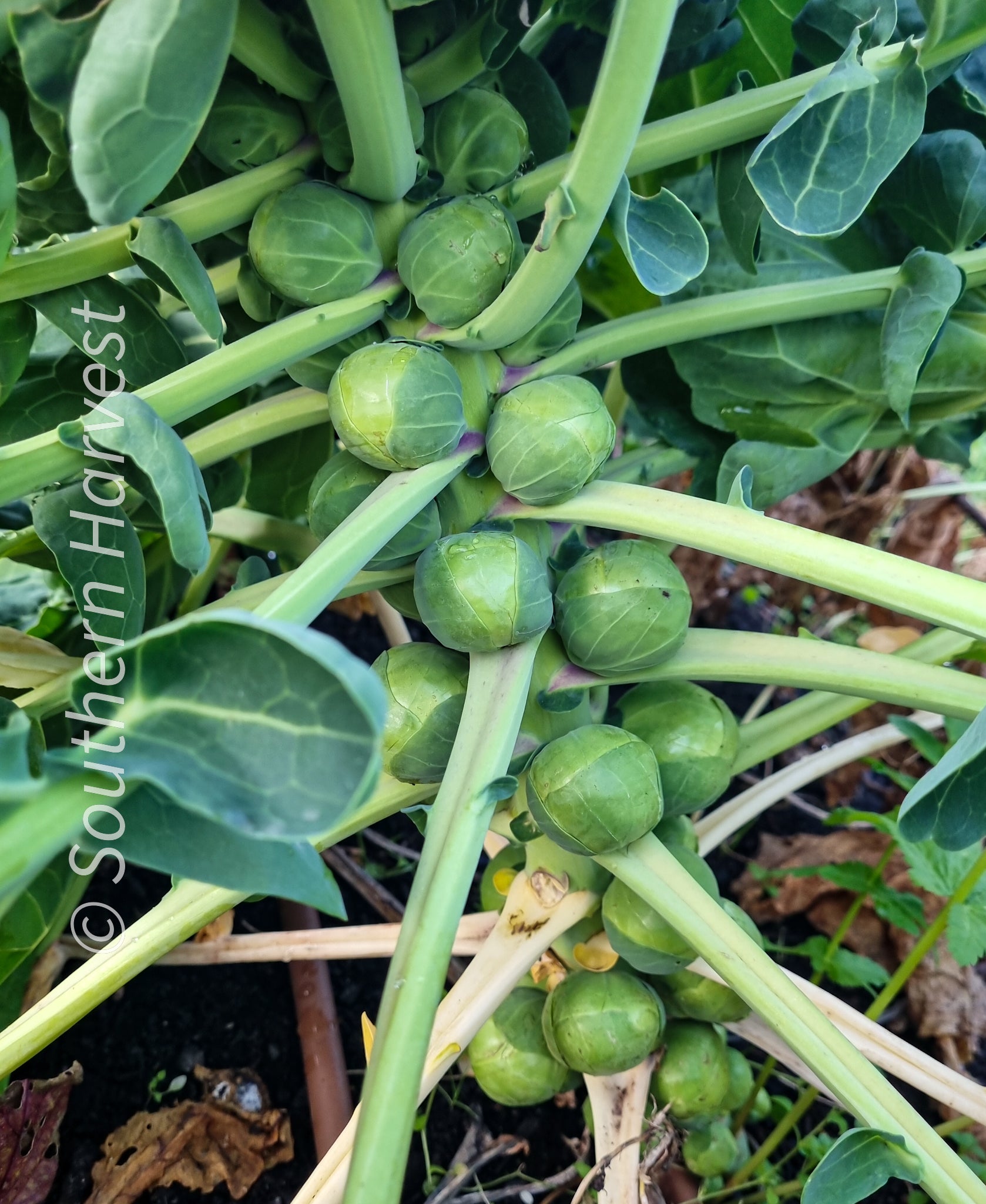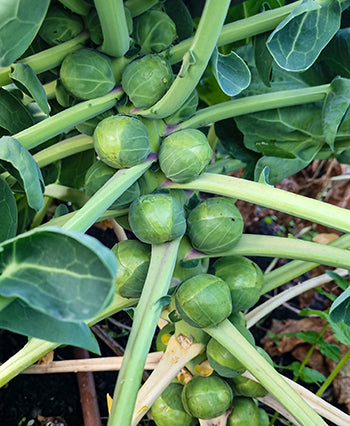How to Grow Brussel Sprouts
The essential guide to growing brussel sprouts from seed; with notes on germination, cultivation, harvest and even kitchen uses.

Seeds per gram (Sds/g): 250–450
Feed Requirements: Moderate
Growing Notes:
Position & Soil
- Soil Type & Drainage:
- Thrives in well-drained loam soil with plenty of organic matter.
- Can handle heavier soils better than many other brassicas (e.g., cabbage, broccoli).
- Aim for a soil pH of around 6.5–7.0.
- Sun Exposure:
- Prefers full sun, though it can tolerate light shade.
Sowing & Germination
- Seed Depth & Spacing:
- Sow seeds 0.5 cm deep.
- Transplant or thin to final spacing of approximately 75 cm between plants and 90 cm between rows, ensuring enough room for tall, spreading plants.
- Sowing Times:
- In cooler regions sow seeds in December/January for the best chance of a high yielding crop. For more temperate regions sow January to early March.
- Germination Temperature & Care:
- Ideal germination temperatures typically range from around 10–28 °C.
- Keep soil/seed mix evenly moist but not waterlogged.
- Germination usually takes 5–14 days, depending on temperature.
Cultivation & General Care
- Fertilizing:
- Requires moderate feeding: apply compost or a balanced organic fertilizer before planting.
- Avoid excessive nitrogen, which causes overly tall plants that can topple in wind.
- A side-dressing of compost or well-balanced fertilizer mid-season can support steady growth.
- Watering:
- Keep soil consistently moist but not saturated—especially during head (sprout) formation.
- Mulching around the base helps maintain even moisture and temperature.
- Staking & Support:
- Taller, later-maturing varieties can reach over 1 m in height. Stake them if they become top-heavy or are in windy locations.
- Weeding & Mulching:
- Control weeds, as they compete for nutrients.
- A light mulch helps suppress weeds and conserve soil moisture.
Potential Problems

-
Aphids & Cabbage Worms:
- Spray Dipel (Bacillus thuringiensis) for cabbage worms.
- Use a pyrethrum-based spray for aphids if infestations are severe.
- Natural predators (ladybugs, lacewings) can help with aphid control.
- To prevent cabbage moth from landing on plants and laying eggs, place a net over so that plants are adequately covered.
-
-
Wind Damage:
- Tall plants may blow over if not staked, especially on exposed sites or in very fertile soil where growth is lush.
Harvesting & Storage
- When to Harvest:
- Sprouts develop from the bottom of the stalk upwards. Harvest when sprouts are firm, about 3-5 cm (or larger if preferred).
- Frost improves sprout flavour, sweetness, and texture—mild frosts increase sugar content and tightness of buds.
- How to Harvest:
- Twist or snap off mature sprouts from the bottom of the stalk first.
- Remove the leaf below each picked sprout to channel the plant’s energy into the developing sprouts above.
- Storage:
- Freshly picked sprouts keep for a week or two in the fridge if unwashed and in a perforated bag.
- For longer storage, blanch and freeze.
Additional Tips & Notes
- Brassica Family & Health:
- Brussels sprouts, like broccoli and cabbage, are high in beneficial phytochemicals and sulfur-containing compounds. These can help detoxify the body and potentially reduce cancer risk.
- Lightly steaming, sautéing, or eating them raw (when very young or shredded) preserves the most nutrients.
- Varieties:
- Later-maturing (taller) varieties can be more productive and often easier to manage.
- Rotation & Soil Health:
- Practice crop rotation with other brassicas to reduce pest and disease buildup in the soil.
By following these guidelines on sowing, spacing, and care—while also encouraging frost exposure near harvest—gardeners can enjoy delicious homegrown Brussels sprouts through much of the cool season.
Sowing Periods
| J | F | M | A | M | J | J | A | S | O | N | D | |
|---|---|---|---|---|---|---|---|---|---|---|---|---|
| Cool | ||||||||||||
| Temperate |
Filters
3 products
BRUSSEL SPROUTS ‘Dagan’ F1
Sale price$3.95
Brussel Sprouts ‘Dagan’ F1
Sale price$4.20
BRUSSEL SPROUTS ‘Long Island Improved’
Sale price$3.75


